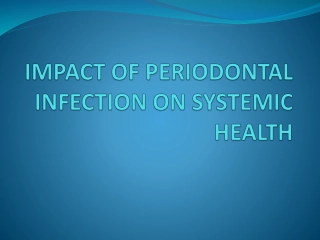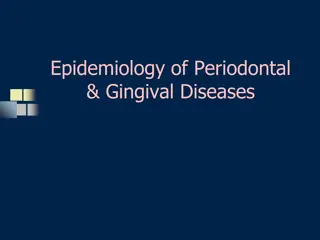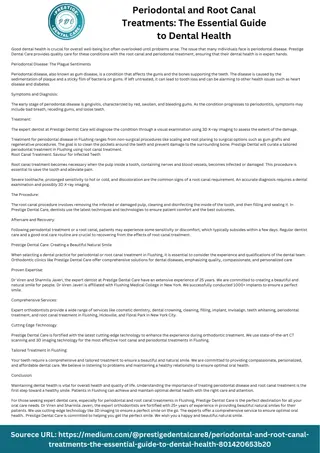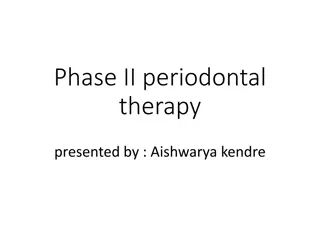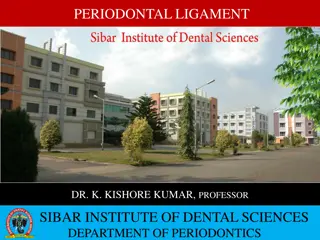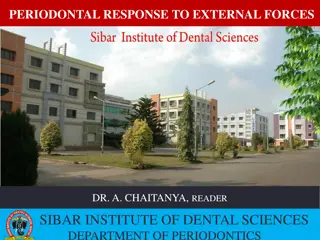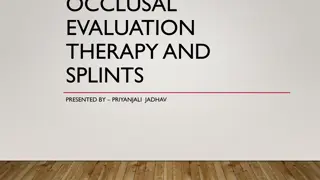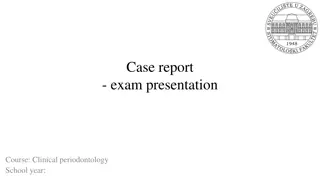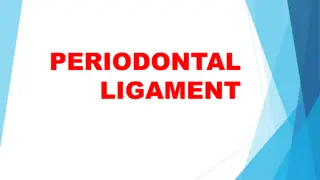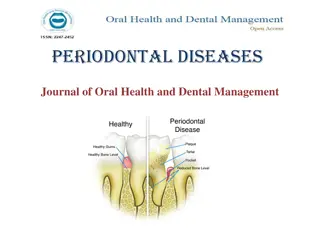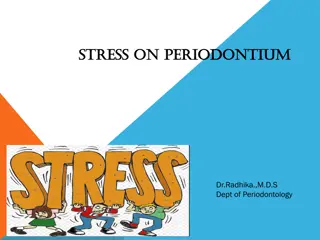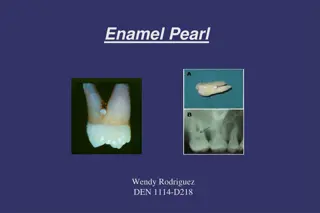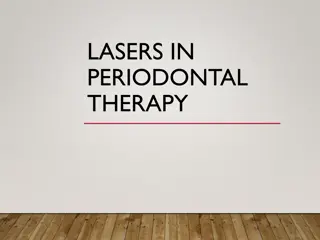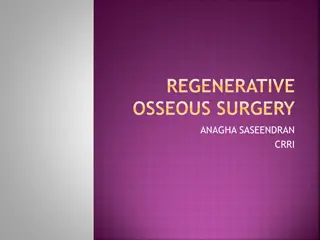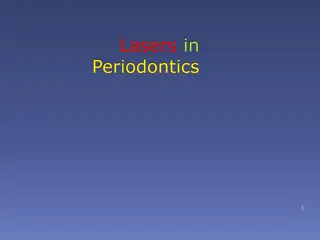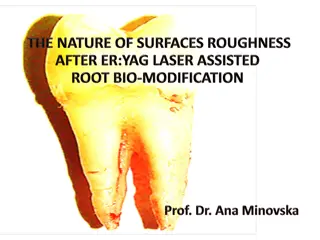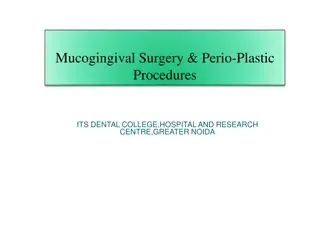Understanding Supportive Periodontal Treatment in Periodontics
Supportive Periodontal Treatment (SPT) is a crucial phase in periodontal therapy aimed at preventing disease recurrence and tooth loss. It involves regular maintenance and monitoring to manage periodontal conditions effectively. SPT includes thorough examinations, radiographic reviews, and prophylaxis to ensure optimal oral health and prevent complications. This comprehensive approach is vital in preserving periodontal health and enhancing overall well-being.
Download Presentation

Please find below an Image/Link to download the presentation.
The content on the website is provided AS IS for your information and personal use only. It may not be sold, licensed, or shared on other websites without obtaining consent from the author. Download presentation by click this link. If you encounter any issues during the download, it is possible that the publisher has removed the file from their server.
E N D
Presentation Transcript
SUPPORTIVE PERIODONTAL TREATMENT DR. C. RAMYA NAGA SHIVANI, SENIOR LECTURER SIBAR INSTITUTE OF DENTAL SCIENCES DEPARTMENT OF PERIODONTICS
Contents : Introduction Sequence of periodontal therapy The therapeutic goals of SPT Rationale for supportive periodontal treatment Maintenance program Radiographic examination SPT for patients with gingivitis Supportive periodontal therapy for patients with periodontitis
Multifactorial risk assessment 1. Percentage of bleeding on probing 2. Prevalence of residual pockets Compliance greater than 4 mm 3. Loss of teeth from a total of 28 Implant maintenance teeth Conclusion 4. Loss of periodontal support in References relation to the patient s age 5. Systemic and genetic conditions 6. Environmental factors such as cigarette smoking. Tooth level risk assessment Site level risk assessment
Introduction: The 3rd World Workshop of the American Academy of Periodontology (1989) renamed this treatment phase SUPPORTIVE PERIODONTAL THERAPY Supportive periodontal therapy is an integral part of periodontal therapy. Supportive periodontal treatment is initiated after completion of active periodontal therapy and continued at periodic intervals for the life of the dentition or its implant re-placement .
SPT should include an update of Medical and dental histories, Radiographic review , Extra oral intraoral soft tissue examination & Dental examination followed by prophylaxis. Niklaus P. Lang, Urs Br gger, Giovanni E. Salvi, and Maurizio S. Tonetti. Supportive Periodontal Therapy (SPT). In Jan Lindhe Niklaus P. Lang Thorkild Karring editors.Clinical Periodontology and Implant Dentistry, 5th edition. Blackwell publishers. p.1297-1316
SEQUENCE OF PERIODONTAL THERAPY: Robert L. Merin. Supportive Periodontal Treatment. In Michael G. Newman, Perry R. Klokkevold, Henry H. Takei, Fermin A. Carranza Editors. Carranza s Clinical Periodontology, 12th Edition. Elsevier Publishers P.667-676.
The therapeutic goals of SPT: Prevent or minimize the recurrence and progression of periodontal disease in patients who have been previously treated for gingivitis , periodontitis & peri implantitis. Prevent or reduce the incidence of tooth loss by monitoring the dentition and any prosthetic replacement of natural teeth. To diagnose and manage, in a timely manner, other diseases or conditions found within or related to the oral cavity Niklaus P. Lang, Urs Br gger, Giovanni E. Salvi, and Maurizio S. Tonetti. Supportive Periodontal Therapy (SPT). In Jan Lindhe Niklaus P. Lang Thorkild Karring editors.Clinical Periodontology and Implant Dentistry, 5th edition. Blackwell publishers. p.1297-1316
Rationale for supportive periodontal treatment: One likely explanation for the recurrence of periodontal disease is incomplete sub gingival plaque removal bacteria are present in the gingival tissues in chronic and aggressive periodontitis. Eradication of intra gingival microorganisms may be necessary for a stable periodontal results. Scaling , root planing and even flap surgery may not eliminate intra gingival bacteria in some areas. These bacteria may recolonize the pocket and cause recurrent disease. Niklaus P. Lang, Urs Br gger, Giovanni E. Salvi, and Maurizio S. Tonetti. Supportive Periodontal Therapy (SPT). In Jan Lindhe Niklaus P. Lang Thorkild Karring editors.Clinical Periodontology and Implant Dentistry, 5th edition. Blackwell publishers. p.1297-1316
Bacteria associated with periodontitis can be transmitted between spouses & other family members . Patients who appear to be successfully treated can become infected or re infected with potential pathogens. Tissues usually do not heal by formation of new connective tissue attachment to root surfaces, but results in a long junctional epithelium from tooth. Niklaus P. Lang, Urs Br gger, Giovanni E. Salvi, and Maurizio S. Tonetti. Supportive Periodontal Therapy (SPT). In Jan Lindhe Niklaus P. Lang Thorkild Karring editors.Clinical Periodontology and Implant Dentistry, 5th edition. Blackwell publishers. p.1297-1316
Subgingival scaling alters the microflora of periodontal pockets. Alterations included a decrease in the proportion of motile rods for 1week, a marked elevation in the proportion of cocoid cells for 21days , and a marked reduction in the proportion of spirochetes for 7 weeks. The return of pathogens to pretreatment levels generally occurs in approximately 9 to 11 weeks but can vary dramatically among patients. Robert L. Merin. Supportive Periodontal Treatment. In Michael G. Newman, Perry R. Klokkevold, Henry H. Takei, Fermin A. Carranza Editors. Carranza s Clinical Periodontology, 12th Edition. Elsevier Publishers P.667-676.
classification: Robert L. Merin. Supportive Periodontal Treatment. In Michael G. Newman, Perry R. Klokkevold, Henry H. Takei, Fermin A. Carranza Editors. Carranza s Clinical Periodontology, 12th Edition. Elsevier Publishers P.667-676.
Robert L. Merin. Supportive Periodontal Treatment. In Michael G. Newman, Perry R. Klokkevold, Henry H. Takei, Fermin A. Carranza Editors. Carranza s Clinical Periodontology, 12th Edition. Elsevier Publishers P.667-676.
Maintenance program: Periodic recall visits form the foundation of a meaningful long term prevention program. The interval between visits is initially set at 3 months but may be varied according to the patient s needs. Periodontal care at each recall visit comprises three parts Robert L. Merin. Supportive Periodontal Treatment. In Michael G. Newman, Perry R. Klokkevold, Henry H. Takei, Fermin A. Carranza Editors. Carranza s Clinical Periodontology, 12th Edition. Elsevier Publishers P.667-676.
Radiographic examination : Radio graphic examination must be individualized , depending on the initial severity of the case and the findings at the recall visit. Robert L. Merin. Supportive Periodontal Treatment. In Michael G. Newman, Perry R. Klokkevold, Henry H. Takei, Fermin A. Carranza Editors. Carranza s Clinical Periodontology, 12th Edition. Elsevier Publishers P.667-676.
Robert L. Merin. Supportive Periodontal Treatment. In Michael G. Newman, Perry R. Klokkevold, Henry H. Takei, Fermin A. Carranza Editors. Carranza s Clinical Periodontology, 12th Edition. Elsevier Publishers P.667-676.
SPT for patients with gingivitis : Lovdal et al 1961, suomi et al 1971-Adults whose effective oralhygine was combined with periodic professional prophylaxis were clearly healther periodontally than patients who did not participate in such programs. Lovdal et al 1961- Study was performed on 1428 adults from an industrial company in Norway. Over 5 yrs ( 2 4 times) Suomi et al 1971- study - loss of periodontal tissue support in young individuals with gingivitis or only loss of small amounts of attachment was followed over 3 yrs. Niklaus P. Lang, Urs Br gger, Giovanni E. Salvi, and Maurizio S. Tonetti. Supportive Periodontal Therapy (SPT). In Jan Lindhe Niklaus P. Lang Thorkild Karring editors.Clinical Periodontology and Implant Dentistry, 5th edition. Blackwell publishers. p.1297-1316
Supportive periodontal therapy for patients with periodontitis : These studies always incorporated the patients into a well organized maintenance care system with recall visits at regular intervals. On average, excellent treatment results with maintained reduced probing depths and maintained gains of probing attachment were documented for most of the patients in the longitudinal studies irrespective of the treatment modality chosen. Niklaus P. Lang, Urs Br gger, Giovanni E. Salvi, and Maurizio S. Tonetti. Supportive Periodontal Therapy (SPT). In Jan Lindhe Niklaus P. Lang Thorkild Karring editors.Clinical Periodontology and Implant Dentistry, 5th edition. Blackwell publishers. p.1297-1316
In a study on 75 patients with extremely advanced periodontitis, who had been successfully treated for the disease with cause-related therapy and modified Widman flap procedures, recurrent infection occurred in only very few sites during a 14-year period of effective SPT. (Lindhe & Nyman 1984) In a periodontitis-susceptible risk population, the majority of patients can be cured provided an optimally organized SPT is performed, while a relatively small proportion of patients (20 25%) will suffer from occasional episodes of recurrent periodontal re infection. Niklaus P. Lang, Urs Br gger, Giovanni E. Salvi, and Maurizio S. Tonetti. Supportive Periodontal Therapy (SPT). In Jan Lindhe Niklaus P. Lang Thorkild Karring editors.Clinical Periodontology and Implant Dentistry, 5th edition. Blackwell publishers. p.1297-1316
Bragger et al. 1992 Initially presenting with mild to moderate periodontitis, the frequency of SPT rendered per year did not affect the rate of progression of periodontal disease. However, patients seeking SPT less than once per year over 8 years lost further periodontal attachment during the period of observation. Axelsson et al 2004 375 test and 180 control (30 yrs) Very few teeth were lost New carious lesions (>80%) 2-4% of all sites exibited periodontal attachment loss of >2mm. Niklaus P. Lang, Urs Br gger, Giovanni E. Salvi, and Maurizio S. Tonetti. Supportive Periodontal Therapy (SPT). In Jan Lindhe Niklaus P. Lang Thorkild Karring editors.Clinical Periodontology and Implant Dentistry, 5th edition. Blackwell publishers. p.1297-1316
Multifactorial risk assessment : (subjective risk assessment) The patients risk for recurrence of periodontitis may be evaluated on the basis of a number of clinical conditions where by no single parameter displays a paramount role. Stefan Renvert, Rutger Persson, Supportive periodontal therapy.Periodontal 2000 2004;36:179-195.
Coding system : Stefan Renvert, Rutger Persson, Supportive periodontal therapy.Periodontal 2000 2004;36:179-195.
The more vectors reaching the score of 5, the higher the risk. The surface area between the various risk scores can provide a numerical score of risk which can be compared to risk scores identified at different time points & guide the clinician to change the SPT strategy. Stefan Renvert, Rutger Persson, Supportive periodontal therapy.Periodontal 2000 2004;36:179-195.
A hypothetical case responded with a decrease in the proportion of sites with bleeding on probing to a score of 12% and to four sites with a maximum pocket probing depth >5mm with a resulting comprehensive risk score of 6.93. Stefan Renvert, Rutger Persson, Supportive periodontal therapy.Periodontal 2000 2004;36:179-195.
Percentage of sites with BOP : BOP percentages reflect a summary of the patient's ability to perform proper plaque control, the patient's host response to the bacterial challenge and the patient's compliance first risk factor . The scale runs in a quadratic mode with 4, 9, 16, 25, 36 and > 49% being the divisions on the vector. Individuals with low mean BOP percentages (< 10% of the surfaces) low risk for recurrent disease , while patients with mean BOP percentages > 25% high risk for reinfection. (Joss et al 1994) Claffey et al. (1990) and Badersten et al. (1990). Niklaus P. Lang, Urs Br gger, Giovanni E. Salvi, and Maurizio S. Tonetti. Supportive Periodontal Therapy (SPT). In Jan Lindhe Niklaus P. Lang Thorkild Karring editors.Clinical Periodontology and Implant Dentistry, 5th edition. Blackwell publishers. p.1297-1316
Prevalence of residual pockets greater than 4 mm : The scale runs in a linear mode with 2, 4, 6, 8, 10 and 12% being the divisions on the vector. Individuals with up to four residual pockets - relatively low risk. More than eight residual pockets - high risk for recurrent disease Niklaus P. Lang, Urs Br gger, Giovanni E. Salvi, and Maurizio S. Tonetti. Supportive Periodontal Therapy (SPT). In Jan Lindhe Niklaus P. Lang Thorkild Karring editors.Clinical Periodontology and Implant Dentistry, 5th edition. Blackwell publishers. p.1297-1316
Presence of high frequencies of deep residual pockets and deepening of pockets during supportive periodontal care - high risk for disease progression (Badersten et al, Claffey et al. 1990). An increased number of residual pockets does not necessarily imply an increased risk for re-infection or disease progression depending on the individual supportive therapy provided, even deeper pockets may be stable without further disease progression for years (Knowles et al. 1979, Lindhe , Nyman 1984). Niklaus P. Lang, Urs Br gger, Giovanni E. Salvi, and Maurizio S. Tonetti. Supportive Periodontal Therapy (SPT). In Jan Lindhe Niklaus P. Lang Thorkild Karring editors.Clinical Periodontology and Implant Dentistry, 5th edition. Blackwell publishers. p.1297-1316
Loss of teeth from a total of 28 teeth : Since tooth loss also represents a true end-point outcome variable reflecting the patient s history of oral diseases and trauma Niklaus P. Lang, Urs Br gger, Giovanni E. Salvi, and Maurizio S. Tonetti. Supportive Periodontal Therapy (SPT). In Jan Lindhe Niklaus P. Lang Thorkild Karring editors.Clinical Periodontology and Implant Dentistry, 5th edition. Blackwell publishers. p.1297-1316
Loss of periodontal support in relation to the patients age : The estimation of the loss of alveolar bone is performed in the posterior region on either periapical radiographs, in which the worst site affected is estimated gross as a % of the root length, or on bite- wing radiographs in which the worst site affected is estimated in mm. Niklaus P. Lang, Urs Br gger, Giovanni E. Salvi, and Maurizio S. Tonetti. Supportive Periodontal Therapy (SPT). In Jan Lindhe Niklaus P. Lang Thorkild Karring editors.Clinical Periodontology and Implant Dentistry, 5th edition. Blackwell publishers. p.1297-1316
One mm is equated with 10% bone loss. The percentage is then divided by the patient's age. As an example, a 40-year- old patient with 20% of bone loss at the worst posterior site affected would be scored BL/Age =0.5. Niklaus P. Lang, Urs Br gger, Giovanni E. Salvi, and Maurizio S. Tonetti. Supportive Periodontal Therapy (SPT). In Jan Lindhe Niklaus P. Lang Thorkild Karring editors.Clinical Periodontology and Implant Dentistry, 5th edition. Blackwell publishers. p.1297-1316
Systemic conditions : Most substantiated evidence - studies on Type I and Type II DM (Gusberti et al. 1983, Emrich et al. 1991,Genco ,Loe 1993) IL-1 genotype positive patients advanced periodontitis lesions (Kornman et al. 1997) Higher tooth loss in the IL-1 genotype positive subjects (McGuire, Nunn 1999) IL-1 genotype positive patients - higher BOP percentages and a higher proportion of patients with higher BOP percentages during a 1-year recall period(Lang et al. 2000) Niklaus P. Lang, Urs Br gger, Giovanni E. Salvi, and Maurizio S. Tonetti. Supportive Periodontal Therapy (SPT). In Jan Lindhe Niklaus P. Lang Thorkild Karring editors.Clinical Periodontology and Implant Dentistry, 5th edition. Blackwell publishers. p.1297-1316
Cigarette smoking : Non-smokers (NS) and former smokers (FS) (more than5 years since cessation) - low risk for recurrence of periodontitis Heavy smokers (HS), as defined by smoking more than one pack per day, - high risk. Occasional (OS; < 10 cigarettes a day) and moderate smokers ( MS) - moderate risk for disease progression Niklaus P. Lang, Urs Br gger, Giovanni E. Salvi, and Maurizio S. Tonetti. Supportive Periodontal Therapy (SPT). In Jan Lindhe Niklaus P. Lang Thorkild Karring editors.Clinical Periodontology and Implant Dentistry, 5th edition. Blackwell publishers. p.1297-1316
Patients Individual periodontal risk assessment : Low Periodontal Risk Patient All parameters within the low risk categories or at the most one parameter in the moderate risk category Niklaus P. Lang, Urs Br gger, Giovanni E. Salvi, and Maurizio S. Tonetti. Supportive Periodontal Therapy (SPT). In Jan Lindhe Niklaus P. Lang Thorkild Karring editors.Clinical Periodontology and Implant Dentistry, 5th edition. Blackwell publishers. p.1297-1316
Moderate Periodontal Risk Patient : Functional diagram of a medium-risk maintenance patient. BOP is 9%, six residual pockets 5 mm are diagnosed, four teeth have been lost, the bone factor in relation to the age is 0.75, the patient is a type I diabetic, but a non-smoker. Niklaus P. Lang, Urs Br gger, Giovanni E. Salvi, and Maurizio S. Tonetti. Supportive Periodontal Therapy (SPT). In Jan Lindhe Niklaus P. Lang Thorkild Karring editors.Clinical Periodontology and Implant Dentistry, 5th edition. Blackwell publishers. p.1297-1316
High Periodontal Risk Patient Functional diagram of a high risk maintenance patient. BOP is 32%, ten residual pockets 5 mm are diagnosed, ten teeth have been lost, the bone factor in relation to the age is 1.25, no systemic factor is known, and the patient is an occasional smoker. Niklaus P. Lang, Urs Br gger, Giovanni E. Salvi, and Maurizio S. Tonetti. Supportive Periodontal Therapy (SPT). In Jan Lindhe Niklaus P. Lang Thorkild Karring editors.Clinical Periodontology and Implant Dentistry, 5th edition. Blackwell publishers. p.1297-1316
The tooth risk assessment : o Tooth position within the dental arch o Furcation involvement o Iatrogenic factors o Residual periodontal support o Mobility Niklaus P. Lang, Urs Br gger, Giovanni E. Salvi, and Maurizio S. Tonetti. Supportive Periodontal Therapy (SPT). In Jan Lindhe Niklaus P. Lang Thorkild Karring editors.Clinical Periodontology and Implant Dentistry, 5th edition. Blackwell publishers. p.1297-1316
Tooth position within the dental arch : A relationship between crowding and increased plaque retention and gingival inflammation has been established.(Ingervall et al. 1977; Buckley 1980; Griffi th & Addy 1981; H rup et al. 1987) crowding of teeth eventually affect the amount of plaque mass formed in dentitions with irregular oral hygiene practices contributing to the development of chronic gingivitis. Niklaus P. Lang, Urs Br gger, Giovanni E. Salvi, and Maurizio S. Tonetti. Supportive Periodontal Therapy (SPT). In Jan Lindhe Niklaus P. Lang Thorkild Karring editors.Clinical Periodontology and Implant Dentistry, 5th edition. Blackwell publishers. p.1297-1316
Furcation involvement: Multi-rooted teeth appear to be at high risk for tooth loss during the maintenance phase. (Hirschfeld & Wasserman 1978; McFall 1982 ) Nordland et al (1987) Periodontal therapy in multi rooted teeth revealed a significant difference between non molar sites and molar flat surfaces on the one hand and molar furcation sites on the other hand. Niklaus P. Lang, Urs Br gger, Giovanni E. Salvi, and Maurizio S. Tonetti. Supportive Periodontal Therapy (SPT). In Jan Lindhe Niklaus P. Lang Thorkild Karring editors.Clinical Periodontology and Implant Dentistry, 5th edition. Blackwell publishers. p.1297-1316
Iatrogenic factors : Overhanging restorations and ill-fitting crown margins - area for plaque retention : abundance of association studies documenting increased prevalence of periodontal lesions in the presence of iatrogenic factors.(Leon 1977) Slightly subgingivally located overhanging restorations will, indeed, change the ecologic niche, providing more favorable conditions for the establishment [of a Gramnegative anaerobic microbiota (Lang et al. 1983). Niklaus P. Lang, Urs Br gger, Giovanni E. Salvi, and Maurizio S. Tonetti. Supportive Periodontal Therapy (SPT). In Jan Lindhe Niklaus P. Lang Thorkild Karring editors.Clinical Periodontology and Implant Dentistry, 5th edition. Blackwell publishers. p.1297-1316
Residual periodontal support there is clear evidence from longitudinal studies that teeth with severely reduced, but healthy, periodontal support can function either individually or as abutments for many years without any further loss of attachment (Nyman & Lindhe 1979; Nyman & Ericsson 1982; Br gger et al. 1990). Niklaus P. Lang, Urs Br gger, Giovanni E. Salvi, and Maurizio S. Tonetti. Supportive Periodontal Therapy (SPT). In Jan Lindhe Niklaus P. Lang Thorkild Karring editors.Clinical Periodontology and Implant Dentistry, 5th edition. Blackwell publishers. p.1297-1316
Mobility: Tooth mobility - an indicator for progressive traumatic lesions. When assessing tooth mobility, it has to be realized that two factors may contribute to hyper mobility. A widening of the periodontal ligament as a result of unidirectional or multidirectional forces to the crown, high and frequent enough to induce resorption of the alveolar bone walls. The height of the periodontal supporting tissues. Niklaus P. Lang, Urs Br gger, Giovanni E. Salvi, and Maurizio S. Tonetti. Supportive Periodontal Therapy (SPT). In Jan Lindhe Niklaus P. Lang Thorkild Karring editors.Clinical Periodontology and Implant Dentistry, 5th edition. Blackwell publishers. p.1297-1316
Periodontally involved teeth show a decrease in mobility following non-surgical and/or surgical periodontal procedures. following surgical procedures, tooth mobility may temporarily increase during the healing phase and may resume decreased values later on. Provisional splinting as an adjunct to non-surgical or surgical therapy does not seem to affect the final result of tooth mobility. Persson 1980, 1981 Niklaus P. Lang, Urs Br gger, Giovanni E. Salvi, and Maurizio S. Tonetti. Supportive Periodontal Therapy (SPT). In Jan Lindhe Niklaus P. Lang Thorkild Karring editors.Clinical Periodontology and Implant Dentistry, 5th edition. Blackwell publishers. p.1297-1316
SITE RISK ASSESSMENT : 1. BOP 2. probing depth 3. loss of attachment 4. suppuration. Niklaus P. Lang, Urs Br gger, Giovanni E. Salvi, and Maurizio S. Tonetti. Supportive Periodontal Therapy (SPT). In Jan Lindhe Niklaus P. Lang Thorkild Karring editors.Clinical Periodontology and Implant Dentistry, 5th edition. Blackwell publishers. p.1297-1316
Bleeding on probing: Absence of BOP periodontal stability Sites repeatedly +ve for BOP 30% probability for attachment loss (Badersten et al., 1985) At 0.25N periodontal stability with 98-99% negative predictive value (Lang et al., 1990) Niklaus P. Lang, Urs Br gger, Giovanni E. Salvi, and Maurizio S. Tonetti. Supportive Periodontal Therapy (SPT). In Jan Lindhe Niklaus P. Lang Thorkild Karring editors.Clinical Periodontology and Implant Dentistry, 5th edition. Blackwell publishers. p.1297-1316
Probing depth and loss of attachment Most commonly assessed , reliable parameter Increased PD reflect history of periodontitis rather than current state of activity Biologic variables like tissue condition and calculus are minimized following Phase I therapy taken as baseline for long-term clinical monitoring (Claffey, 1994) Niklaus P. Lang, Urs Br gger, Giovanni E. Salvi, and Maurizio S. Tonetti. Supportive Periodontal Therapy (SPT). In Jan Lindhe Niklaus P. Lang Thorkild Karring editors.Clinical Periodontology and Implant Dentistry, 5th edition. Blackwell publishers. p.1297-1316
Suppuration Increased positive predictive value for disease progression in combination with BOP and PD Indicates that the site is undergoing a period of exacerbation (Kaldahl et al., 1990) Niklaus P. Lang, Urs Br gger, Giovanni E. Salvi, and Maurizio S. Tonetti. Supportive Periodontal Therapy (SPT). In Jan Lindhe Niklaus P. Lang Thorkild Karring editors.Clinical Periodontology and Implant Dentistry, 5th edition. Blackwell publishers. p.1297-1316
Continuous multiple level risk assessment. Subject, tooth and site parameters are combined to establish the clinical risk for disease progression. Note that different sites in the same patient may have a different level of risk. Subject-based risk factors are used to put the tooth and /or site risk assessment in perspective.
Compliance: It has been defined as "the extent to which a person's behavior coincides with medical or health advice" (Haynes1976). Compliance with personal oral hygiene: Improving oral hygiene compliance : E.Brady Hancock, Donald H. Preventive strategies and supportive treatment. Periodontal2000 2001;25:59-76.
Maintenance for patients with dental implants: In general, procedures for maintenance of patients with implants are similar to those with natural teeth, with three differences: 1. Special instrumentation that will not scratch the implants . 2. Acidic fluoride prophylactic agents are avoided. 3. Non abrasive prophylactic pastes are used. Niklaus P. Lang, Urs Br gger, Giovanni E. Salvi, and Maurizio S. Tonetti. Supportive Periodontal Therapy (SPT). In Jan Lindhe Niklaus P. Lang Thorkild Karring editors.Clinical Periodontology and Implant Dentistry, 5th edition. Blackwell publishers. p.1297-1316
Depending on the clinical, radiographic, diagnosis, protocols for preventive and therapeutic measures were designed to intercept the development of peri-implant lesions. The major clinical parameters to be used include: Presence or absence of plaque Presence or absence of BoP Presence or absence of suppuration Increased peri-implant probing depth Evidence and extent of radiographic alveolar bone loss. Niklaus P. Lang, Urs Br gger, Giovanni E. Salvi, and Maurizio S. Tonetti. Supportive Periodontal Therapy (SPT). In Jan Lindhe Niklaus P. Lang Thorkild Karring editors.Clinical Periodontology and Implant Dentistry, 5th edition. Blackwell publishers. p.1297-1316
Niklaus P. Lang, Urs Brgger, Giovanni E. Salvi, and Maurizio S. Tonetti. Supportive Periodontal Therapy (SPT). In Jan Lindhe Niklaus P. Lang Thorkild Karring editors.Clinical Periodontology and Implant Dentistry, 5th edition. Blackwell publishers. p.1297-1316


